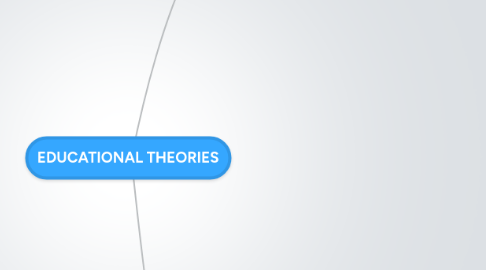
1. LEARNING THEORIES
1.1. BEHAVIOURISM
1.1.1. Theorists: Pavlov, Skinner, Watson, Thorndike
1.1.2. Operant Conditioning (Reinforcement and Punishment/ Positive or Negative)
1.1.2.1. Reinforcement: to increase the likelyhood of a behaviour
1.1.2.1.1. + Reinforcement: the addition of a stimuli to increase the chance of the behaviour being repeated
1.1.2.1.2. - Reinforcement: the removal of a stimuli to increase the change of the behaviour being repeated
1.1.2.2. Punishment: to decrease the likelyhood of a behaviour
1.1.2.2.1. + Punishment (Presentational Punishment): the addition of a stimuli to decrease the chance of the behaviour being repeated
1.1.2.2.2. - Punishment (Removal Punishment): the removal of a stimuli to decrease the chance of the behaviour being repeated
1.1.3. Key Ideas: modelling, shaping, cuing, drill & practice (for rote memorization)
1.1.4. Implications for Education:
1.1.4.1. teachers provide direct instruction --> teacher-centered classroom
1.1.4.2. primary mode of delivery: lectures
1.1.4.3. teachers focus on the learning objectives and curriculum through direct instruction
1.1.4.4. Behaviour analysis--> using operant conditioning to change the student's behaviour
1.1.5. Technological Tools:
1.1.5.1. Math Blaster (for skill and drill)
1.1.5.2. iClickers
1.1.5.3. Computer Assisted Instruction/Computer Assisted Assessment
1.1.5.4. Online Tutorials
1.2. COGNITIVE LOAD
1.2.1. Theorists: Piaget, Gagne, Vygotstky, Bruner
1.2.2. (1900) as a response to behaviourism
1.2.3. Key Ideas: schema (activate background knowledge) and memory systems
1.2.4. Memory Model: Sensory Short term Long term
1.2.4.1. Tools to help Working Memory
1.2.4.1.1. Reading and comprehension
1.2.4.1.2. Motivation (does this topic motivate you?)
1.2.4.1.3. Repetition (practice for retention)
1.2.4.1.4. Mneumonic Devices
1.2.4.1.5. Metaphor/Symbolism
1.2.4.1.6. Organizational scheme
1.2.4.1.7. Make it meaningful (to activate background knowledge)
1.2.4.1.8. Chunking
1.2.5. Types of Technology
1.2.5.1. Electronic Note Taking
1.2.5.2. One Note
1.2.5.3. Track Changes (on word or Google Docs)
1.2.5.4. Goodnotes
1.2.5.5. LMSs (Learning Management Systems) (ex. moodle, eClass)
1.2.6. Implications for Education
1.2.6.1. learning structures: how teachers organize and present their information (CHUNKING)
1.2.6.2. instructional design: how information is presented (ex. through interface)
1.2.6.3. may only focus on remembering the information without direct application & use of higher order Bloom's
1.3. CONSTRUCTIVISM
1.3.1. Theorists: Piaget, Vygostky, Dewey, Montessori
1.3.1.1. Montessori: learning should be connected to real-life authentic situations and the real world
1.3.2. Key idea: People actively construct their own knowledge through the interactions and experiences with the environment
1.3.3. People are active agents in their learning
1.3.4. conceptual growth is based on the person's perception
1.3.5. Implications for Education:
1.3.5.1. Use complex problems and teach basic skills while solving these problems
1.3.5.2. the teacher is the facilitator and applies scaffolding to help guide the student to understanding
1.3.5.3. Problem based learning and the use of authentic tasks
1.3.5.4. Discovery learning (hands on)
1.3.6. Technological Tools:
1.3.6.1. Scratch (programming software)
1.3.6.2. SIMS
1.3.6.3. robotics
1.3.6.4. Google Sites & Wikispaces
1.4. CONNECTIVISM
1.4.1. Theorists: Siemens, Downes
1.4.1.1. Siemens: "knowledge is distributed across a network of connections, and therefore that learning consists of the ability to construct and traverse those networks"
1.4.1.2. Siemens: "knowledge is...literally the set of connections formed by actions and experience."
1.4.2. learning theory in the digital age
1.4.3. Learning is a process of creating connections and developing networks
1.4.3.1. the greater the number of connections we build and maintain, the more we are able to learn
1.4.4. learning is not solely dependent on others, technological devices contributes to building our knowledge
1.4.5. through connections and networks, you can build your social capital and obtain currency in the form of accurate & up-to-date knowledge
1.4.6. Ability to connect various ideas, points of knowledge and concepts
1.4.7. Technological Tools: Social Networking Sites
1.4.7.1. Twitter
1.4.7.2. Facebook
1.4.7.3. LinkedIn
1.4.7.4. Search Engines: Google, Yahoo
1.4.7.5. Email, webcam, chat, discussion groups
2. TECHNOLOGY THEORIES
2.1. SOCIAL CONSTRUCTION OF TECHNOLOGY (SCOT)
2.1.1. Human action and society influences the development and use of technology
2.1.1.1. "social norms, attitudes, cultural practices...directly impact how technology is used" (Quan-Haase, 2013, p. 47).
2.1.1.2. technology is contextual and its use varies with the culture and societal group that uses it
2.1.1.3. technology fills gaps that are determined by societal needs
2.2. MEDIA ECOLOGY
2.2.1. Technology influences society and humans
2.2.1.1. Technological Evolution
2.2.1.2. Technological Determinism
2.2.1.2.1. Societal and cultural changes arise because of technology
2.2.1.2.2. technology is autonomous entity
2.2.1.2.3. people need to adapt to the effects of technology
